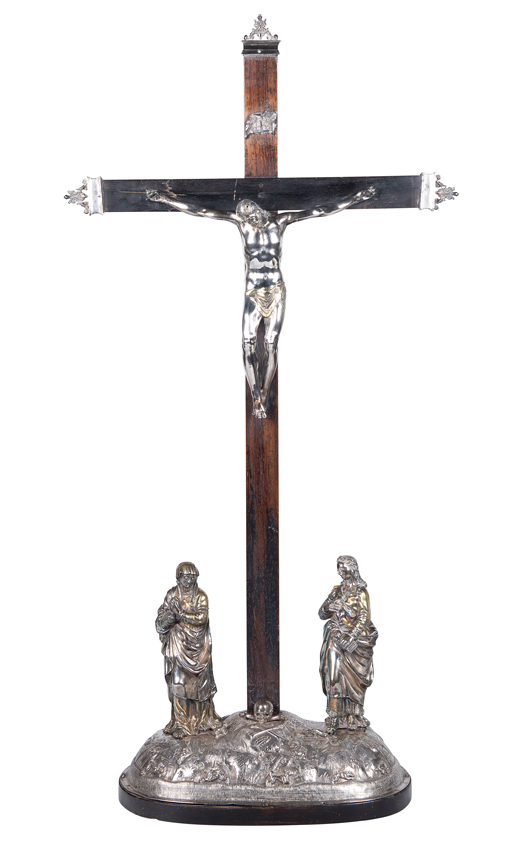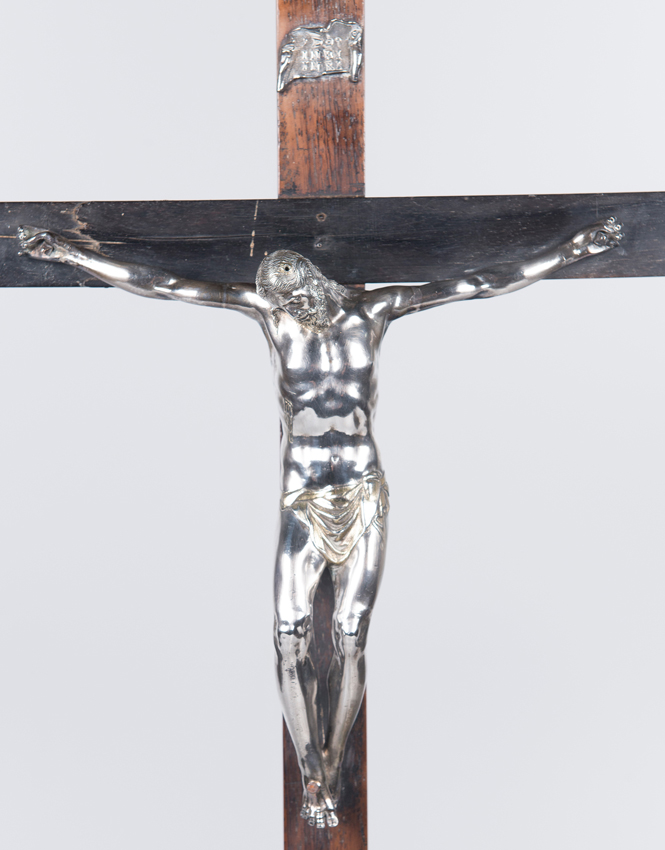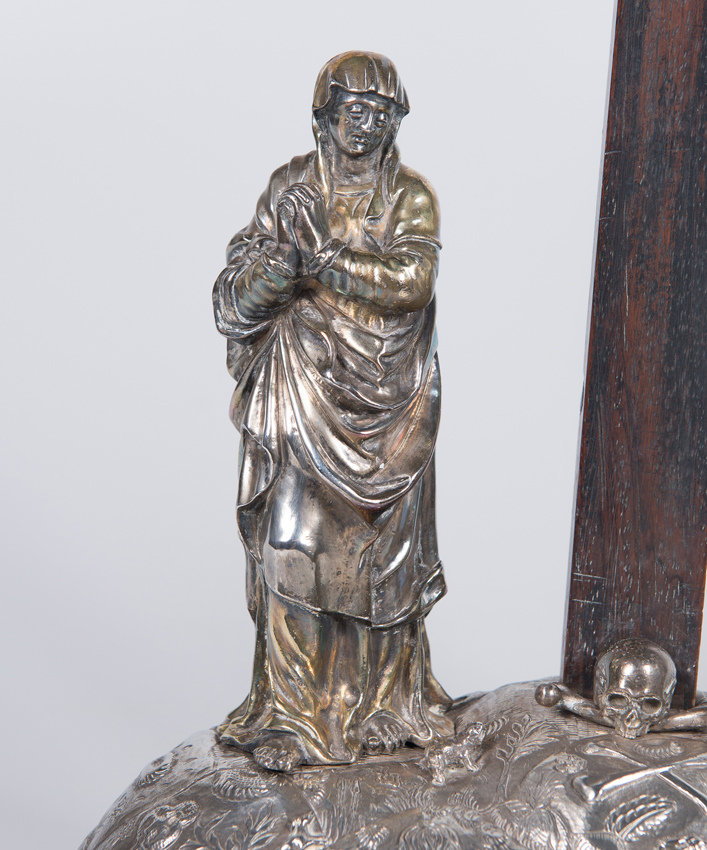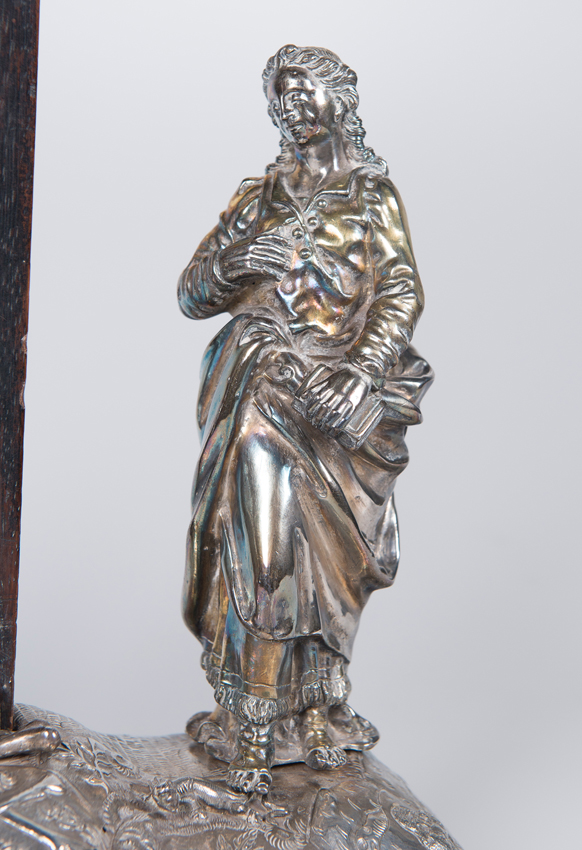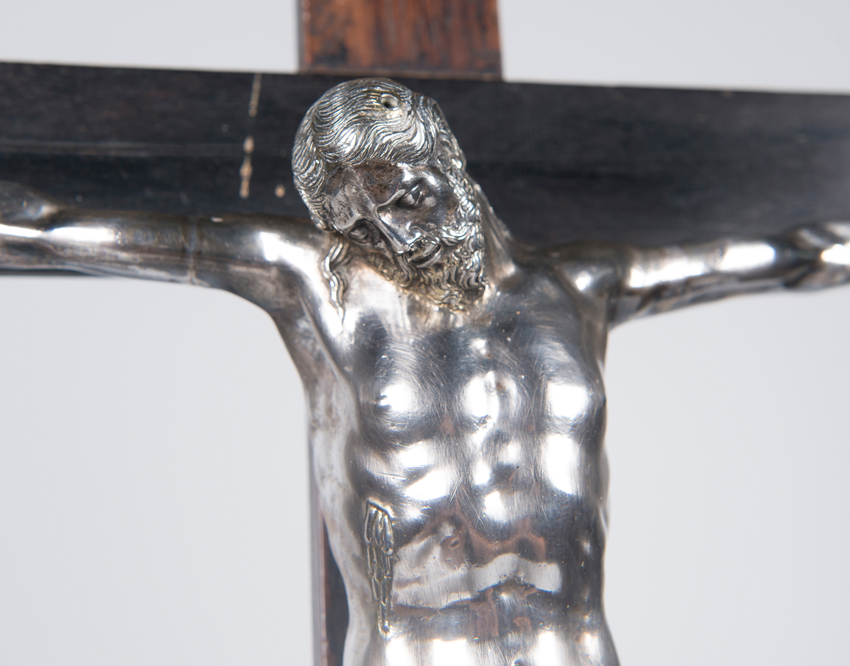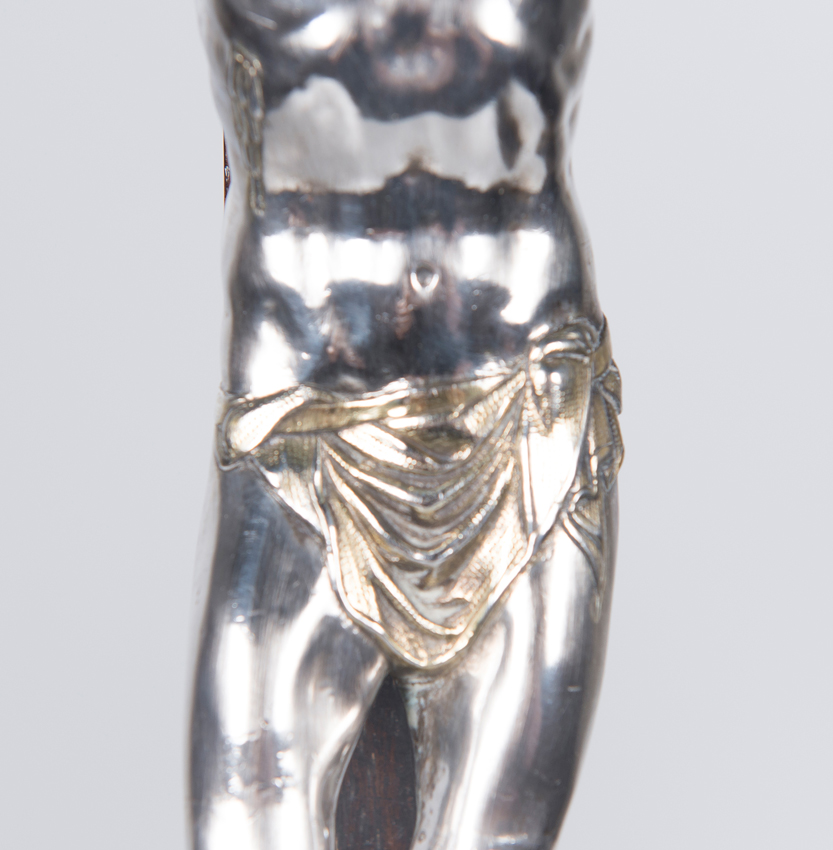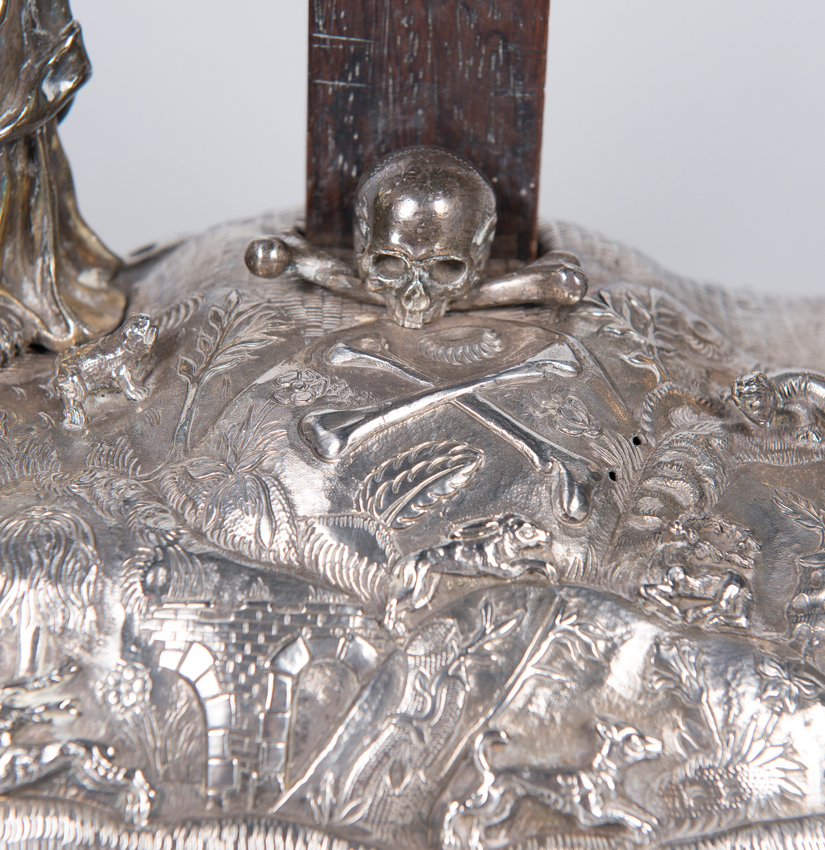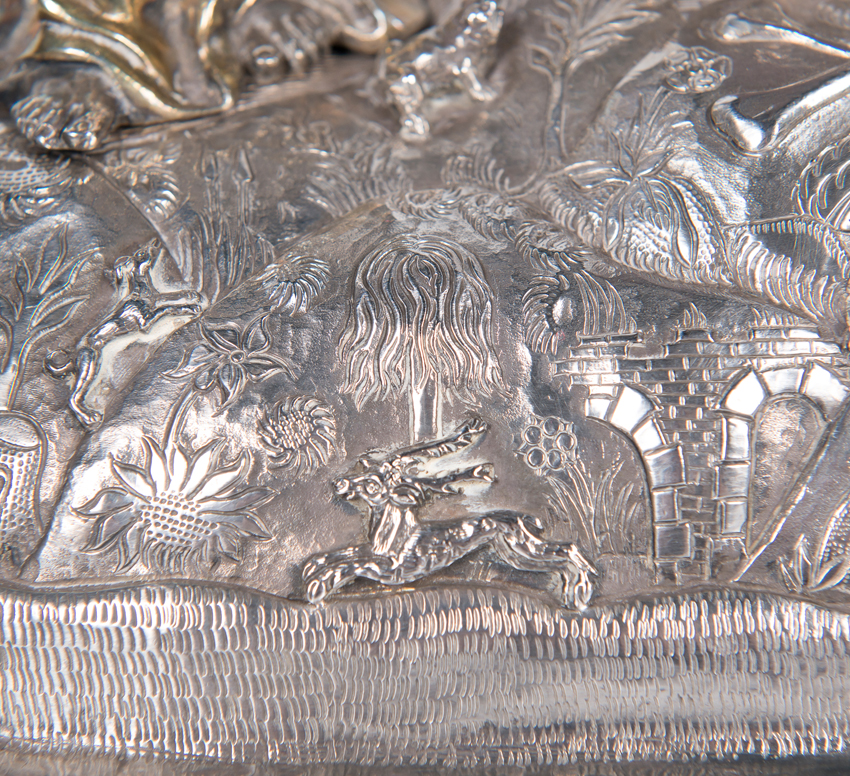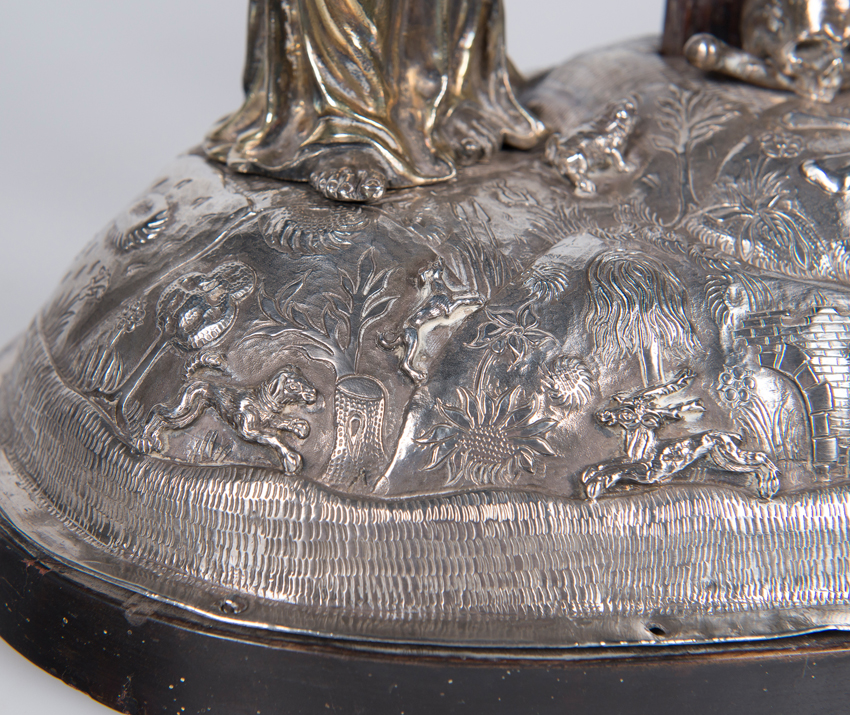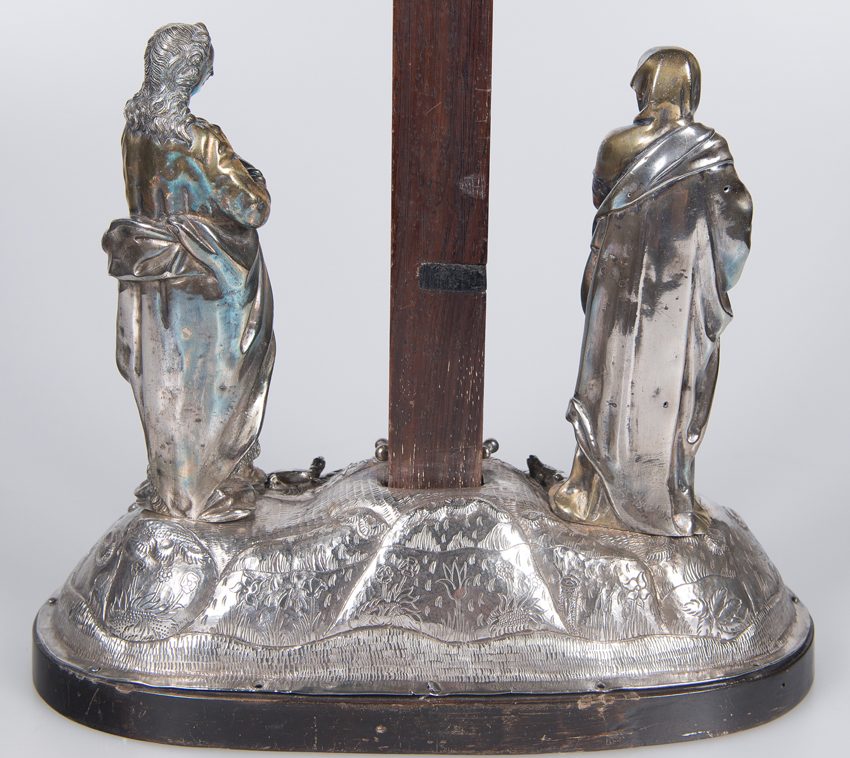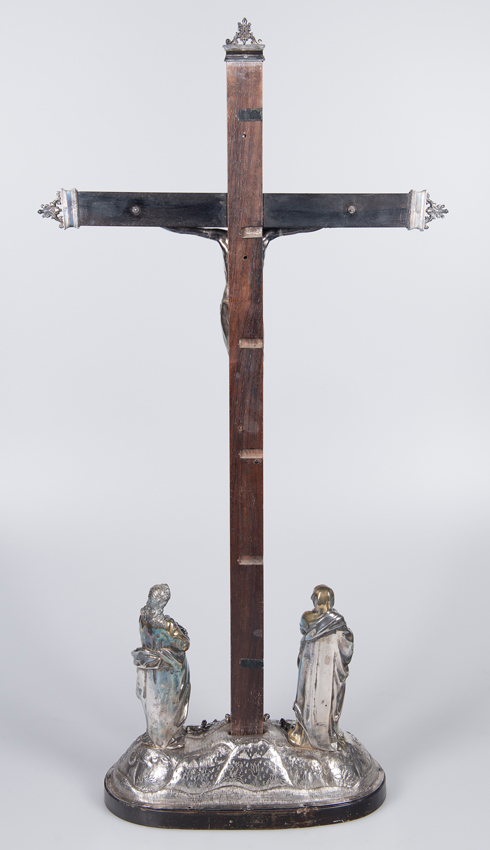25
Attributed to Pompeo Leoni (Milan, circa 1533 - Madrid, 1608)
Attributed to Pompeo Leoni (Milan, circa 1533 - Madrid, 1608)
Magnificent ensemble in wrought, embossed, and chiselled silver with traces of gilding.
Measurements: 82 x 41 x 17 cm
Although made with different materials, there is a clear stylistic and iconographic relationship between this piece and the Christ from the main altarpiece of the Church of San Lorenzo in El Escorial by Pompeo Leoni, as well as the Crucified Christ (inv. E-268) from around 1605, which is housed in the Museum of the Royal Academy of Fine Arts of San Fernando. The latter work, whose authorship had long been debated—it was also attributed to Antón de Morales—was recently reattributed to Pompeo Leoni due to its undeniable and evident quality following the cleaning of its polychrome surface. This reattribution is discussed in the fascinating study "El Cristo crucificado de la Academia de San Fernando recuperado para Pompeo Leoni" published in Ars Magazine, by Alfonso Rodríguez G. de Ceballos, Emeritus Professor of Modern Art History at the Autonomous University of Madrid. In the article, Ceballos delves into the existing connection between the Academy's sculpture and the one in El Escorial. As we began by explaining, we associate both pieces with this magnificent Calvary in silver.
In this regard, as Ceballos explains in the Ars Magazine article, Leone Leoni and his son Pompeo created, in the gilded bronze Calvary of El Escorial, "a unique archetype that their collaborators and disciples would go on to replicate many times. The elder Leoni had already created, circa 1549—long before being commissioned to make the bronzes for the altarpiece in El Escorial—a sculptural group on an ebony base (measuring 110 x 33 cm), in which he anticipated on a small scale what would become the monumental Calvary that crowns the altarpiece of the royal monastery. The only difference was the absence of the figure of Mary Magdalene crouching at the foot of the Cross in the later version. The extraordinary beauty of the Crucified Christ and the harmonious figures of the Virgin and Saint John who accompany him had already captivated Guglielmo della Porta, who between 1575 and 1581 composed the same scene on a gilded silver plaque."
[...]
Naturally, this is the same formula repeated on a monumental scale in the Calvary of the El Escorial altarpiece, as well as in the altarpiece for the [...] Convent of San Diego in Valladolid, commissioned in 1605 from Pompeo, although this time the material changed from bronze to wood." In our view, Pompeo Leoni repeated this same archetype in the piece we have here—this time adapting it from bronze to gilded silver.
Focusing on his biography and artistic career, we draw from the Historia Hispánica portal (of the Royal Academy of History), which describes the artist as an Italian sculptor who established himself in Madrid and whose figure and personality, "linked to but independent from that of his father, are of particular interest due to the way they bridge Italy and Spain." His presence and artistic development "help to explain the unique conception of court sculpture, the symbolic imagery of power, and its role in the evolution of a specific genre like Spanish sculpture, contributing to a formal renewal with palpable consequences for the artists in his sphere of influence."
To understand Leoni’s impact and influence on Spanish and European religious imagery, we quote the conclusion of his biography in the Prado Museum’s official database: "Drawing from the work of Michelangelo—the genius who influenced all artists of his time—and from the study of classical antiquity, the Leonis, working between Milan and Madrid, along with Giambologna in Florence, became, during the second half of the 16th century and the early 17th century, the most important sculptural force that spread throughout Europe. They assumed a diplomatic and cultural prominence that has never since been surpassed."
Pompeo Leoni is, ultimately, a major figure in European sculptural art, whose creative skill is widely documented through a long, fruitful, and brilliant connection to the Spanish Court;
the establishment of a prolific workshop in Madrid, independent from his father's in Milan (though he frequently collaborated with his father until his death, at which point Pompeo completed some of his unfinished works); and a body of masterworks, such as the aforementioned pieces and the funerary sculptures of Princess Joanna of Portugal, the tomb of Inquisitor Valdés, and that of Cardinal Espinosa. According to art historian Manuel Arias Martínez in Historia Hispánica, these "are three true landmarks in the sculptural arts, confirming Pompeo Leoni's role as the most outstanding sculptor of Philip II’s reign."
His masterpiece, according to the Prado Museum, is "the mausoleums of Charles V and Philip II, located in the church of the monastery of El Escorial on either side of the main altar." He created them "with the collaboration of another Italian sculptor, Jacopo Nizzolo da Trezzo, and the renowned goldsmith Juan de Arfe," as his father had already passed away. Art historian Rosario Coppel Aréizaga notes for the Prado that "in these impressive sculptural groups, he returned to the style of his early sculptural work, linking back to the first series that had established both him and his father as the finest portrait sculptors of their time."
As for stylistic characteristics—which we observe in the piece we present, as well as in the two sculptures we compare it to—the artist's personal hallmark is best described by Arias Martínez in his article as: "an idealized naturalism, elegant and with clear classical undertones, executed with a high degree of technical skill that distinguished him as the quintessential court sculptor."
In October 2011, an international symposium was held at the Study Center of the Prado Museum, dedicated to the Leoni father and son. Titled "The Art of Leone and Pompeo Leoni: Their Sculptures in Madrid and El Escorial," it was directed by Professor Dr. Stephan Schröder and featured talks such as "The Calvary by Pompeo Leoni for the Main Altar of El Escorial" and "Pompeo Leoni and the Silver Portrait of Philip II in Vienna", delivered respectively by Rosemarie Mulcahy, Associate Professor at University College Dublin, and Claudia Kryza-Gersch, then curator at the Kunstkammer/Schatzkammer of the Kunsthistorisches Museum in Vienna. Both lectures are highly relevant to the magnificent piece we present for auction.
References / Bibliography:
- Arias Martínez, Manuel. (s.f.). "Pompeo Leoni". Historia Hispánica. Real Academia de la Historia. https://historia-hispanica.rah.es/biografias/25669-pompeo-leoni
- Coppel Aréizaga, Rosario. (s.f.). "Leoni, Pompeo". Museo del Prado. https://www.museodelprado.es/aprende/enciclopedia/voz/leoni-pompeo/ec3f9df0-e2b9-48fc-b972-2315c1cc7ddd
- Rodríguez G. de Ceballos, Alfonso. (2013). "El Cristo crucificado de la Academia de San Fernando recuperado para Pompeo Leoni" in "Ars magazine: revista de arte y coleccionismo", Nº. 19 (pp. 56-66).
Attributed to Pompeo Leoni (Milan, circa 1533 - Madrid, 1608)
Magnificent ensemble in wrought, embossed, and chiselled silver with traces of gilding.
Measurements: 82 x 41 x 17 cm
Although made with different materials, there is a clear stylistic and iconographic relationship between this piece and the Christ from the main altarpiece of the Church of San Lorenzo in El Escorial by Pompeo Leoni, as well as the Crucified Christ (inv. E-268) from around 1605, which is housed in the Museum of the Royal Academy of Fine Arts of San Fernando. The latter work, whose authorship had long been debated—it was also attributed to Antón de Morales—was recently reattributed to Pompeo Leoni due to its undeniable and evident quality following the cleaning of its polychrome surface. This reattribution is discussed in the fascinating study "El Cristo crucificado de la Academia de San Fernando recuperado para Pompeo Leoni" published in Ars Magazine, by Alfonso Rodríguez G. de Ceballos, Emeritus Professor of Modern Art History at the Autonomous University of Madrid. In the article, Ceballos delves into the existing connection between the Academy's sculpture and the one in El Escorial. As we began by explaining, we associate both pieces with this magnificent Calvary in silver.
In this regard, as Ceballos explains in the Ars Magazine article, Leone Leoni and his son Pompeo created, in the gilded bronze Calvary of El Escorial, "a unique archetype that their collaborators and disciples would go on to replicate many times. The elder Leoni had already created, circa 1549—long before being commissioned to make the bronzes for the altarpiece in El Escorial—a sculptural group on an ebony base (measuring 110 x 33 cm), in which he anticipated on a small scale what would become the monumental Calvary that crowns the altarpiece of the royal monastery. The only difference was the absence of the figure of Mary Magdalene crouching at the foot of the Cross in the later version. The extraordinary beauty of the Crucified Christ and the harmonious figures of the Virgin and Saint John who accompany him had already captivated Guglielmo della Porta, who between 1575 and 1581 composed the same scene on a gilded silver plaque."
[...]
Naturally, this is the same formula repeated on a monumental scale in the Calvary of the El Escorial altarpiece, as well as in the altarpiece for the [...] Convent of San Diego in Valladolid, commissioned in 1605 from Pompeo, although this time the material changed from bronze to wood." In our view, Pompeo Leoni repeated this same archetype in the piece we have here—this time adapting it from bronze to gilded silver.
Focusing on his biography and artistic career, we draw from the Historia Hispánica portal (of the Royal Academy of History), which describes the artist as an Italian sculptor who established himself in Madrid and whose figure and personality, "linked to but independent from that of his father, are of particular interest due to the way they bridge Italy and Spain." His presence and artistic development "help to explain the unique conception of court sculpture, the symbolic imagery of power, and its role in the evolution of a specific genre like Spanish sculpture, contributing to a formal renewal with palpable consequences for the artists in his sphere of influence."
To understand Leoni’s impact and influence on Spanish and European religious imagery, we quote the conclusion of his biography in the Prado Museum’s official database: "Drawing from the work of Michelangelo—the genius who influenced all artists of his time—and from the study of classical antiquity, the Leonis, working between Milan and Madrid, along with Giambologna in Florence, became, during the second half of the 16th century and the early 17th century, the most important sculptural force that spread throughout Europe. They assumed a diplomatic and cultural prominence that has never since been surpassed."
Pompeo Leoni is, ultimately, a major figure in European sculptural art, whose creative skill is widely documented through a long, fruitful, and brilliant connection to the Spanish Court;
the establishment of a prolific workshop in Madrid, independent from his father's in Milan (though he frequently collaborated with his father until his death, at which point Pompeo completed some of his unfinished works); and a body of masterworks, such as the aforementioned pieces and the funerary sculptures of Princess Joanna of Portugal, the tomb of Inquisitor Valdés, and that of Cardinal Espinosa. According to art historian Manuel Arias Martínez in Historia Hispánica, these "are three true landmarks in the sculptural arts, confirming Pompeo Leoni's role as the most outstanding sculptor of Philip II’s reign."
His masterpiece, according to the Prado Museum, is "the mausoleums of Charles V and Philip II, located in the church of the monastery of El Escorial on either side of the main altar." He created them "with the collaboration of another Italian sculptor, Jacopo Nizzolo da Trezzo, and the renowned goldsmith Juan de Arfe," as his father had already passed away. Art historian Rosario Coppel Aréizaga notes for the Prado that "in these impressive sculptural groups, he returned to the style of his early sculptural work, linking back to the first series that had established both him and his father as the finest portrait sculptors of their time."
As for stylistic characteristics—which we observe in the piece we present, as well as in the two sculptures we compare it to—the artist's personal hallmark is best described by Arias Martínez in his article as: "an idealized naturalism, elegant and with clear classical undertones, executed with a high degree of technical skill that distinguished him as the quintessential court sculptor."
In October 2011, an international symposium was held at the Study Center of the Prado Museum, dedicated to the Leoni father and son. Titled "The Art of Leone and Pompeo Leoni: Their Sculptures in Madrid and El Escorial," it was directed by Professor Dr. Stephan Schröder and featured talks such as "The Calvary by Pompeo Leoni for the Main Altar of El Escorial" and "Pompeo Leoni and the Silver Portrait of Philip II in Vienna", delivered respectively by Rosemarie Mulcahy, Associate Professor at University College Dublin, and Claudia Kryza-Gersch, then curator at the Kunstkammer/Schatzkammer of the Kunsthistorisches Museum in Vienna. Both lectures are highly relevant to the magnificent piece we present for auction.
References / Bibliography:
- Arias Martínez, Manuel. (s.f.). "Pompeo Leoni". Historia Hispánica. Real Academia de la Historia. https://historia-hispanica.rah.es/biografias/25669-pompeo-leoni
- Coppel Aréizaga, Rosario. (s.f.). "Leoni, Pompeo". Museo del Prado. https://www.museodelprado.es/aprende/enciclopedia/voz/leoni-pompeo/ec3f9df0-e2b9-48fc-b972-2315c1cc7ddd
- Rodríguez G. de Ceballos, Alfonso. (2013). "El Cristo crucificado de la Academia de San Fernando recuperado para Pompeo Leoni" in "Ars magazine: revista de arte y coleccionismo", Nº. 19 (pp. 56-66).
Millésime 25 · 20th anniversary of La Suite Subastas
Sale Date(s)
Venue Address
General delivery information available from the auctioneer
The purchase price includes the delivery of the lots in the venue of the auction. Transporting to other destinations is at the own risk of the client. The customer must contact "LST", to give the corresponding instructions for such transporting. "LST" is not responsible for the packaging or any accident incurred during transportation.
Important Information
It is important please, that you read our conditions of sale before the auction. If you need us to send them to you by mail, just ask for them.
We would like to remind you that in compliance with Spanish historical heritage laws, lots over 100 years old will need a license, which we will take care of processing for you. This process can take up to a month, as the Ministry of Culture holds only one meeting per month.
The Spanish administration does not charge anything for clients within the European Community, but for non-European Community buyers, the Spanish administration does apply fees. Please contact us for more details on the cost of these fees.
Terms & Conditions
CONDITIONS OF THE AUCTION:
I. REGISTRATION. To bid in the room customers must register at the beginning, filling out a form and picking a number that will identify them during the auction. Customers may be required to register in bank references or other guarantee system and if they do not prove the solvency "LST" will not accept bids and award the auction.
II. WRITTEN BIDS. "LST" will accept written bids, which will be formalized in the form provided by the room until the day before the auction. In such auctions, the room will bid in name of the client until the maximum stated in the offer and always at the lowest possible price. If there are two or more bids for the same amount, the one placed first will have the priority. Written bids received in advance, will have priority on the day of the auction.
III. TELEPHONE BIDS. "LST" will allow telephone bids, if interested people contact "LST" days before the auction providing personal data, ID card and the phone number which will be used by the staff of "LST" to call at the time of the auction. The buyer, within all the legal rights is making an offer for the asking price, when applies for telephone bid. "LST" will not take responsibility for any technical defects beyond its control, which may prevent to contact successfully the bidder during the auction.
IV. AUCTIONEER. The auction will be conducted by an auctioneer, director of the auction will be judge and arbitrator of it with full authority in its development, will award the lots to the highest bidder and is able to settle any controversy concerning lots sale, reject bids, divide lots or group them and remover objects from the room. Will be able to, if it is deemed suitable, not accept bids on the auction. His decision will be unappealable.
V. SALE OF LOTS. The lots are awarded to the highest bidder. Once the auctioneer blows the hammer, the buyer becomes responsible of the lot purchased, exempting "LST" of liability to for any damage and / or accidents that may occur. No refunds of lots.
VI. STARTING PRICE. The amount shown in the catalogue as the starting price for each lot will be, as a rule, the minimum selling price, except for exceptional cases where a reservation may be agreed upon with the seller or it set discretionary by the room.
VII. SCALE OF BIDS. The bids are set according to the following scale:
From 50.-€ to 200.-€…………………………………………..at 10.-€
From 200.-€ to 500.-€…………………………………… …25 in 25.-€
From 500.-€ to 1.000.-€………………………………..…..….50 in 50.-€
From 1.000.-€ to 2.000.-€………………………………..…100 in 100.-€
From 2.000.-€ to 5.000.-€……………………………….….250 in 250.-€
From 5.000.-€ to 10.000.-€…………………………………500 in 500.-€
From 10.000.-€ to 20.000.-€……………………………1.000 in 1.000.-€
From 20.000.-€ to 50.000.-€……………………………2.500 in 2.500.-€
From 50.000.-€ to 100.000.-€…………………………..5.000 in 5.000.-€
From 100.000.-€ to 100.000.-€………………………10.000 in 10.000.-€
From 200.000.-€ to 200.000.-€………………………25.000 in 25.000.-€
From 500.000.-€ to 500.000.-€………………………50.000 in 50.000.-€
VIII. RIGHT OF ADMISION. "LST" reserves the right to admission to the auction room and to reject, at its judgment, any purchase order, from clients whose solvency is not duly proved as well as not to sale auctions.
IX. SALE PRICES. The successful bidder of one or more lots must pay "LST" the final sale price achieves at auction, plus the 24,5 % plus 21% VAT on the commission, at total 29,64 % on Hammer Price.
X. CATALOG DATA. The catalogue data are obtained in order to careful research and advice, however, any responsibility is afforded about its accuracy. The lots will be auctioned in the state in which they are, not accepting any claims in restorations, breakage, damage, imperfections and, even description or numbering mistakes in the catalogue, in case of it, being the burden of the buyers to make sure before the auction that the description matches with their personal opinion about respective lot. The exhibition of the lots is intended to allow a perfect review and study of them.
XI. PAYMENT AND REMOVAL OF LOTS. Payment and removal of the lots will be held no later than five days following the auction. After this period expire without having the buyer removed the lot or lots purchases, it will accrue an expense of custody of 6 euros per day on each lot.
15 days after the auction without having the buyer paid and removes the sold lots, "LST" will inform the seller and there will begin judicial proceeding in order to obtain payment. The delay in payment by the purchaser of his/her sold lots will carry an interest increase at a rate of 1,5% per month.
XII. DELIVERY OF LOTS. The purchase price includes the delivery of the lots in the venue of the auction. Transporting to other destinations is at the own risk of the client. The customer must contact "LST", to give the corresponding instructions for such transporting. "LST" is not responsible for the packaging or any accident incurred during transportation.
XIII. RIGHT OF FIRT REFUSAL AND REPURCHASE. "LST" in order to article 38 of "Ley 16/1985 de 25 Junio del Patrimonio Histórico Español" (BOE. 155 June 29, 1985), will notify in advance to the Ministry of Culture, the content of their catalogues. Concerning the lots subject to the legislation referred to in the preceding paragraph, the Administration may exercise the rights of first refusal and repurchase according to the law. "LST" will watch over the protection of Artistic, Historical and Bibliographical Heritage of Spain. For customers out of European Community, a tax for export is required by the Administration.
XIV. EXPORT LICENSE. In compliance with Spanish historical heritage laws, lots over 100 years old need a export license, which we will take care of processing for you. The Spanish administration does not charge anything for clients within the European Community, but for non-European Community buyers, the Spanish administration does apply fees. Please contact us for more details on the cost of these fees.
XV. VALUE ADDED TAX (I.V.A). This tax will be accrued on commissions of "LST" for buyers, using the rates prevailing on the date of the auction.
XVI. DATA PROTECTION. In order to the "Ley 15/1999 de 13 de Diciembre, de Protección de Datos de Carácter Personal", the client authorize "LST", the inclusion of their data in a customer file, and for the promotion by "LST" of the objects at all times the rights of access, rectification or deletion of personal data by sending the appropriate request to the following address: LA SUITE SUBASTAS, C/ Conde Salvatierra, 8, 08006. Barcelona.
XVII. EXPRESS LEGAL JURISDICTION. These Conditions are governed by and interpreted in accordance with the rules of Spanish law. The mere act of participating in the auction as seller, buyer or bidder, implies acceptance of these Terms and Conditions.
Sales operations are understood to be held at the registered office of "LST", C/ Conde de Salvatierra, 8, 08006. Any dispute shall be taken to the competent courts of Barcelona, expressly waiving any other jurisdiction, in accordance with Article 55 of the "Ley de Enjuiciamiento Civil".


























